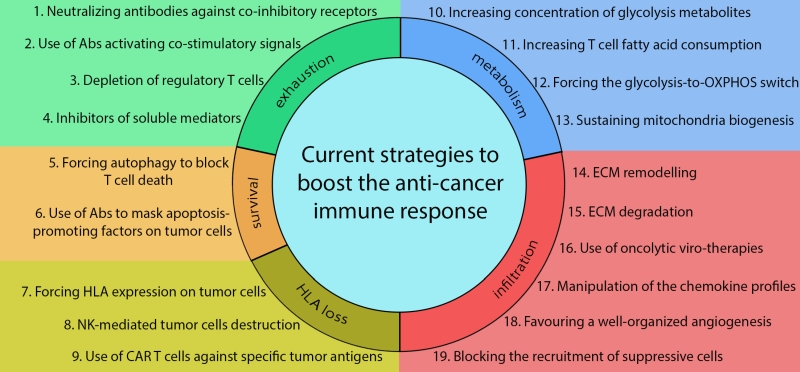Back to article: T lymphocytes against solid malignancies: winning ways to defeat tumours
FIGURE 1: Current strategies to increase anti-cancer immune responses. The panel summarizes current strategies adopted in clinical trials or in basic research to increase the efficacy of immune-therapies against solid malignancies. Acting on T-cell exhaustion, researchers are currently testing the possibility to use soluble antibodies to neutralize co-inhibitory receptors (1) or to activate co-stimulatory signals on T cells (2). Other approaches involve depletion of immune suppressive Tregs (3) or the inhibition of soluble mediators produced by immune suppressive populations (4). Moreover, strategies could be adopted to prevent T-cell death inside the TME, by forcing autophagy in T cells (5) or by inhibiting the interaction between apoptosis-promoting factors on the tumour cell surface with apoptosis receptors on T cells using soluble neutralizing antibodies (6). In those cases, in which tumor cells evade the immune response due to a lack of antigen presentation, it is possible to force HLA expression on tumor cells (7) or to exploit the ability of NK cells to recognize and kill HLA-negative cells (8). Very recently, engineered CAR T cells have been used for their ability to kill tumour cells expressing specific antigens (10). Moreover, T cell functionality inside the TME may be increased through the modulation of its metabolism by increasing glycolysis metabolite concentration in the TME (10), by forcing T cells to utilize alternative substrates, such as fatty acids (11) or OXPHOS substrates (12), or by directly sustaining their mitochondria biogenesis and oxidative metabolism (13). Finally, several approaches are currently adopted to increase T-cell infiltration into the TME by forcing the expression of specific molecules by T cells, which can thus remodel (14) or completely degrade (15) the extracellular matrix (ECM), also by means of oncolytic-viruses (16). In addition, T-cell infiltration can be increased by modifying the chemokines expressed into the TME (17) or favouring a well-organized angiogenesis (18), which increases the ability of T cells to invade the tumour-surrounding stroma. By contrast, modulation of the chemokine profile could be used to prevent recruitment of suppressive immune populations into the TME (19). See text for details.

